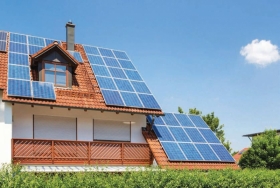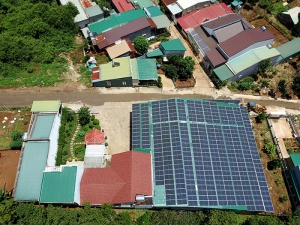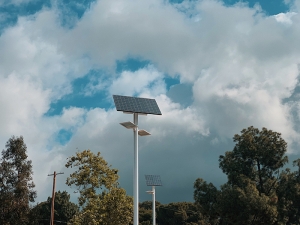Find the optimal angle for mounting solar panels
- 06-01-2022 11:30:15
- 86
Concept of inclination angle and azimuth
Tilt angle: The longitudinal inclination of the plate
Horizontal Angle: The horizontal direction of the plates (relative to the Equator).
Solar panel systems work best when they face the sun directly. But that task is complicated by the fact that the sun never stands still and shines in one direction throughout the day. It will also change the projection angle when changing from season to season.
So when you're building a solar system, the question is: what's the best angle to mount the panels to get the most output?
Many people install the system without paying attention to this problem, so the power output is still not operating at its optimum. Their system could have operated much more efficiently if they had calculated in navigating the installation corner
Method to find the optimal angle for mounting solar panels
For example: You are living in Vietnam in the Northern Hemisphere, to increase the efficiency of the solar power system you should direct the solar panels to the South.
Many people are surprised to find that their compass is not completely accurate. This is because magnetic influences within the Earth's interior cause the compass needle to deviate from the true points of south and north. The degree of deviation depends on your geographical location, the compass can give an error of up to 25°.
The difference between compass north (with magnetic influence) and true north is called magnetic declination. Based on this number, you can know at the installation location how many degrees the system needs to compensate to find the true north.
Magnetic declination is a positive number representing eastward declination, which means true north is east of north in the compass. In contrast, true north is to the west of north in the compass.
Depending on the geographical location where you install the system, the magnetic attenuation of the compass will vary. You can consult the correct information from the experts of the supplier when installing the system.
Optimum tilt angle without adjustment

One thing to consider is that you can change the tilt slightly to favor summer or winter output. If your demand for electricity is higher in the summer, you can adjust it to optimize your ability to produce electricity in the summer. Conversely, you can tune your panels to be optimal for winter if your winter power usage is higher.
This is more important for off-grid systems, as you have to store and control your electricity usage. If you own a grid-tied solar system you will most likely want to optimize for summer production, because in the summer more sunlight leads to higher power output, plus Then, when connecting to the grid, if the excess electricity from the production of the solar system will be purchased by the power company, in the winter, you will not have to worry about not having electricity for living. Summary:
- To optimize overall year-round production: tilt at your latitude.
- To favor more production in summer: tilt at your latitude minus 10°
- To favor more production in winter: lean at your latitude plus 10-15°.
Adjust the optimal tilt angle according to the season
.jpg)
There is a note for you if you are in an area with heavy snowfall in winter. The accumulation and accumulation of snow on the panels negatively affects their performance, so in the winter with heavy snowfall you can adjust the tilt of the panels a little steeper. This not only improves production, but also prevents snow from sticking to the surface of the panels.
If you have time to adjust the tilt angle of your solar panels a few times per year, here is the adjustment schedule we recommend you apply:
- Spring: Tilt the panels to your latitude.
- Summer: Tilt the panels to your latitude and subtract 10°.
- Fall: Tilt the panels to your latitude.
- Winter: Tilt the panels to your latitude and add 10-15°.
Notes on using and protecting solar panels
- It is necessary to determine the most optimal position and orientation before installing the solar battery.
- If the tilt angle of the solar panel is not reached, rainwater and dew will collect water or accumulate dust. This directly affects the solar radiation absorption part of the panel. In particular, this affects the annual maintenance and cleaning costs.
- Clean and maintain the entire system for best performance. Therefore, you need to clean the dust on the surface of the solar panel because this directly affects the absorption of solar radiation no matter how thick or thin the dust layer is. As such, if not cleaned properly solar panels can lose around 15-25% of their efficiency. Ideally, you should clean the panel from 1 to 2 times within 1 year. This will result in a system increase of 3.5 to 5.1% in power output (compared to non-cleaned units) within 1 year.
- Remove all obstructions that prevent sunlight from reaching the panel to prevent the panel's performance from being affected.
News other
-

How many types of solar inverters are there?
10-01-2022 17:15:06 Details
-

Install a solar battery system properly
10-01-2022 16:25:02 Details
-

The Vietnam Renewable Energy Community organizes a Caravan journey towards the Central region
10-01-2022 09:12:28 Details
-

Solar panel system rotates in the direction of the sun – Up to 30% higher efficiency
10-01-2022 09:11:15 Details
-

Why is solar power in the Central Highlands extremely ”hot” in 2020?
10-01-2022 09:04:02 Details
-

What are solar lights?
10-01-2022 09:01:07 Details



.jpg)